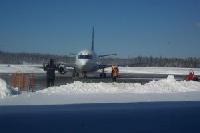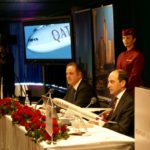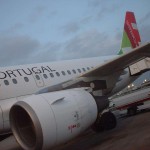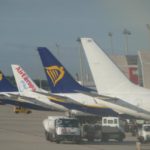With the arrival of the cold weather, Czech Airlines (ČSA) finally had to fully deploy its plane de-icing equipment.
The equipment was fully deployed this year much later than in an average winter season due to the unseasonably warm temperatures in December and early January. While last year the airline’s technical staff had already treated 1,600 planes by this date, this year they have so far only had to de-ice 300 aircraft. The full blown ‚de-icing season‘ at Prague’s airport didn’t begin until this week in response to the rapid drop in temperatures and the final arrival of snowy weather. The spraying of aircraft with de-icing fluid starts as soon as the temperature starts to approach the freezing point. This is when there is the risk of frost and an ice buildup, which could negatively impact the flying capabilities of the plane.
ČSA de-ices its own fleet as well as the aircraft of a number of other airlines. At Prague, this service is also offered by two other companies – Menzies and Letiště Praha. In terms of market share, ČSA handles roughly 75% of the aircraft de-icing at Prague’s airport.
On average, the winter season, during which de-icing is done, lasts from December through March. Last year, the weather was particularly harsh and ČSA de-iced a total of 2,799 aircraft. In an average winter season, the airline de-ices approximately 2,000 planes. Approximately 100 litres of de-icing fluid is required to de-ice one Boeing 737 or Airbus A320 plane. If a thicker build-up of wet or frozen snow has to be removed, the fluid consumption per aircraft can reach as much as 600-700 litres. All surface areas of Prague’s airport are specially drained and the surface runoff and chemicals are collected into the airport’s waste water treatment plant.
[GADS_NEWS]The de-icing process
To perform the de-icing, ČSA uses special trucks, each of which is equipped with three tanks. Two of the tanks contain different types of de-icing fluid and the last contains hot water. The first type of fluid used is mixed with water in specific proportions and this mixture is then used to spray down the entire aircraft at a temperature of 60°C. This chemical fluid mixture dissolves all ice and removes any snowy buildup on the surface of the aircraft. The important part is to make sure that the ice doesn’t build up on the plane again during takeoff when the aircraft uses all of its power for the takeoff and can’t activate any of its own de-icing features such as the heating of the leading edges of the wings, etc. This is why immediately after being sprayed with the first de-icing mixture, the aircraft is sprayed with a second special fluid, which creates a film on the surface of the aircraft to retard any further ice from building up.
This preventative film remains effective for only about 40 minutes. Therefore, the entire de-icing process has to be completed shortly before the takeoff of the plane, after the passengers are already on board and just before the plane is ready to taxi to the runway. The de-icing treatment is applied by special trucks and ČSA owns five of them. The most modern of these vehicles, acquired by the airline just this winter, is capable of de-icing the largest commercial airplane in the world – the Airbus A380.
*****
Czech Airlines (ČSA) – the largest national carrier of the new EU member countries according to the number of passengers carried. In 2006, the airline carried a record 5.5 million passengers. Since 2001, it has been a member of SkyTeam, one of the leading global airline alliances. ČSA currently offers connections to 120 destinations in 45 countries worldwide. The fleet contains 50 aircraft – ATR 42’s/72’s, Boeing 737’s and Airbus A310/A320/A321’s.
For the last three years, ČSA has been selected as the “Best Airline Based in Central/Eastern Europe – 2004, 2005 and 2006”. This title is awarded annually by the Official Airline Guide (OAG) and is based on the votes of frequent business travellers.
In January 2006, Czech Airlines also won the “Best Airline in Eastern Europe” Award (the Annual GT Tested Awards) for a second year running. ČSA was also on the shortlist of the eight best world airlines in 2005.






